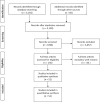Developing an evidence base of best practices for integrating computerized systems into the exam room: a systematic review
- PMID: 27539198
- PMCID: PMC7651892
- DOI: 10.1093/jamia/ocw121
Developing an evidence base of best practices for integrating computerized systems into the exam room: a systematic review
Abstract
Objective: The introduction of health information technology systems, electronic health records in particular, is changing the nature of how clinicians interact with patients. Lack of knowledge remains on how best to integrate such systems in the exam room. The purpose of this systematic review was to (1) distill "best" behavioral and communication practices recommended in the literature for clinicians when interacting with patients in the presence of computerized systems during a clinical encounter, (2) weigh the evidence of each recommendation, and (3) rank evidence-based recommendations for electronic health record communication training initiatives for clinicians.
Methods: We conducted a literature search of 6 databases, resulting in 52 articles included in the analysis. We extracted information such as study setting, research design, sample, findings, and implications. Recommendations were distilled based on consistent support for behavioral and communication practices across studies.
Results: Eight behavioral and communication practices received strong support of evidence in the literature and included specific aspects of using computerized systems to facilitate conversation and transparency in the exam room, such as spatial (re)organization of the exam room, maintaining nonverbal communication, and specific techniques that integrate the computerized system into the visit and engage the patient. Four practices, although patient-centered, have received insufficient evidence to date.
Discussion and conclusion: We developed an evidence base of best practices for clinicians to maintain patient-centered communications in the presence of computerized systems in the exam room. Further work includes development and empirical evaluation of evidence-based guidelines to better integrate computerized systems into clinical care.
Keywords: electronic health records; evidence-base; health information technology; patient-clinician communication.
© The Author 2016. Published by Oxford University Press on behalf of the American Medical Informatics Association. All rights reserved. For Permissions, please email: journals.permissions@oup.com
Figures
References
-
- Roter DL, Hall JA. Doctors Talking with Patients/patients Talking with Doctors: Improving Communication in Medical Visits. 2nd ed.Westport, CT: Praeger; 2006.
-
- Shachak A, Reis S. The impact of electronic medical records on patient-doctor communication during consultation: a narrative literature review. J Eval Clin Pract. 2009;154:641–649. - PubMed
-
- Blumenthal D. Stimulating the adoption of health information technology . N Engl J Med. 2009;36015:1477–1479. - PubMed
-
- Blumenthal D, Tavenner M. The “meaningful use” regulation for electronic health records. N Engl J Med. 2010;3636:501–504. - PubMed
Publication types
MeSH terms
Grants and funding
LinkOut - more resources
Full Text Sources
Other Literature Sources
Medical


